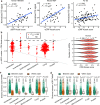Determinants of genome-wide distribution and evolution of uORFs in eukaryotes
- PMID: 33597535
- PMCID: PMC7889888
- DOI: 10.1038/s41467-021-21394-y
Determinants of genome-wide distribution and evolution of uORFs in eukaryotes
Erratum in
-
Author Correction: Determinants of genome-wide distribution and evolution of uORFs in eukaryotes.Nat Commun. 2021 Mar 31;12(1):2101. doi: 10.1038/s41467-021-22435-2. Nat Commun. 2021. PMID: 33790278 Free PMC article. No abstract available.
Abstract
Upstream open reading frames (uORFs) play widespread regulatory functions in modulating mRNA translation in eukaryotes, but the principles underlying the genomic distribution and evolution of uORFs remain poorly understood. Here, we analyze ~17 million putative canonical uORFs in 478 eukaryotic species that span most of the extant taxa of eukaryotes. We demonstrate how positive and purifying selection, coupled with differences in effective population size (Ne), has shaped the contents of uORFs in eukaryotes. Besides, gene expression level is important in influencing uORF occurrences across genes in a species. Our analyses suggest that most uORFs might play regulatory roles rather than encode functional peptides. We also show that the Kozak sequence context of uORFs has evolved across eukaryotic clades, and that noncanonical uORFs tend to have weaker suppressive effects than canonical uORFs in translation regulation. This study provides insights into the driving forces underlying uORF evolution in eukaryotes.
Conflict of interest statement
The authors declare no competing interests.
Figures







Similar articles
-
Dual modes of natural selection on upstream open reading frames.Mol Biol Evol. 2007 Aug;24(8):1744-51. doi: 10.1093/molbev/msm093. Epub 2007 May 9. Mol Biol Evol. 2007. PMID: 17494029
-
Genome-wide identification of Arabidopsis non-AUG-initiated upstream ORFs with evolutionarily conserved regulatory sequences that control protein expression levels.Plant Mol Biol. 2023 Jan;111(1-2):37-55. doi: 10.1007/s11103-022-01309-1. Epub 2022 Aug 31. Plant Mol Biol. 2023. PMID: 36044152
-
Upstream open reading frames and Kozak regions of assembled transcriptome sequences from the spider Cupiennius salei. Selection or chance?Gene. 2014 Apr 15;539(2):203-8. doi: 10.1016/j.gene.2014.01.079. Epub 2014 Feb 12. Gene. 2014. PMID: 24530309
-
Function and Evolution of Upstream ORFs in Eukaryotes.Trends Biochem Sci. 2019 Sep;44(9):782-794. doi: 10.1016/j.tibs.2019.03.002. Epub 2019 Apr 16. Trends Biochem Sci. 2019. PMID: 31003826 Review.
-
Regulation of plant translation by upstream open reading frames.Plant Sci. 2014 Jan;214:1-12. doi: 10.1016/j.plantsci.2013.09.006. Epub 2013 Sep 18. Plant Sci. 2014. PMID: 24268158 Review.
Cited by
-
Understanding the regulation of protein synthesis under stress conditions.Biophys J. 2024 Oct 15;123(20):3627-3639. doi: 10.1016/j.bpj.2024.09.014. Epub 2024 Sep 14. Biophys J. 2024. PMID: 39277792
-
Principles, mechanisms, and biological implications of translation termination-reinitiation.RNA. 2023 Jul;29(7):865-884. doi: 10.1261/rna.079375.122. Epub 2023 Apr 6. RNA. 2023. PMID: 37024263 Free PMC article.
-
An Inner Mitochondrial Membrane Microprotein from the SLC35A4 Upstream ORF Regulates Cellular Metabolism.J Mol Biol. 2024 May 15;436(10):168559. doi: 10.1016/j.jmb.2024.168559. Epub 2024 Apr 3. J Mol Biol. 2024. PMID: 38580077 Free PMC article.
-
Translational control of murine adiponectin expression by an upstream open reading frame element.RNA Biol. 2023 Jan;20(1):737-749. doi: 10.1080/15476286.2023.2256094. RNA Biol. 2023. PMID: 37702393 Free PMC article.
-
High Polymorphism Levels of De Novo ORFs in a Yoruba Human Population.Genome Biol Evol. 2024 Jul 3;16(7):evae126. doi: 10.1093/gbe/evae126. Genome Biol Evol. 2024. PMID: 38934859 Free PMC article.
References
Publication types
MeSH terms
Substances
LinkOut - more resources
Full Text Sources
Other Literature Sources

